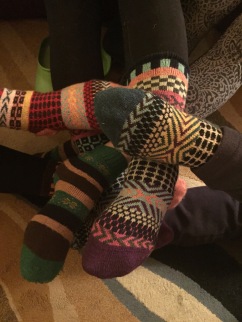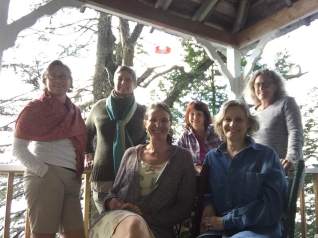As difficult as it is now to imagine, as I child I was beyond timid. While in my imagination I could make things that were beautiful to my child-eyes, swim all day without tiring, ride a pony into the sunset, speak my mind without shaking, in actuality I was frequently frustrated by art that didn’t match the intricate mandalas I could see in my head before I knew what a mandala was, a pony so stubborn she wouldn’t take a step without cajoling, a body so terrified of deep water that I’d rather tremble at the edge of the pool than jump in (and the ocean?–for toes only), a voice that shook and hands that sweated so badly I’d have to wipe them multiple times during any test. Now, I’m deeply grateful and certainly not complaining about what was, all told, an idyllic beginning on this planet. But the felt gap between the desire to get “out there” artistically, physically, intellectually and my perception of my ability to embody this free, artistic person I longed to be was, at times and for decades, crippling. It’s been, shall we say, a theme for me.
I blame only myself for this. It’s like knowing you’re so far from your longing that you see only a corner of it through a telescope whose eyepiece has been blacked out. You think the lens is very, very small until you realize that if you clean the eyepiece, you can see; the irony is that you were just so darn close to the eyepiece that you couldn’t see it, really, at all, much less fix it–and where you can see, one day you can go. But until the voice telling me to go for it was my own, until I could feel in my body that failure is more a possibility I can learn from than a death trap–only then could I get out of my little self in little ways and keep pushing outward from a center that knows that the extent of what is possible only grows.
Now, in a season of change when rock-solid friends are dying young and my list of must-dos seems to lengthen with every breath, I realize I’m again at the edge of the water, frustrated that my Crayola art looks little like the Sistine Chapel, that Taffy the dark, dappled Welsh pony with the gorgeous flaxen mane is snorting, stock-still. She used to keep that up for so long (it seemed like fifteen minutes but was probably more like three) that I would give up, dismount, and walk her back to the shed. My friends that said you have to get back on after any buck or disappointment didn’t understand that my ride just wouldn’t move. 
(Wikipedia, “Welsh Pony and Cob”)
So here I am again, not that different, I suppose, from anyone else, wondering what’s next and how to reach it. The difference for me from my younger self is the richness I’ve found inside myself. (You can be brought up in the church and still take a rather long time to reach this point, I’ve learned.) The Source of all goodness is source for everyone (I’m not talking about creeds here)–I feel this in my core. It is that love I seek to embody, that that gets me out of bed. Breathing it in, filling with it feeds, resurrects. The mindfulness we now agree is transformative (in homes, in schools, in artists) is a moment-to-moment invitation. I find myself wondering, instead of whether I will evolve as an artist, how, which of several projects to prioritize artistically.
What does it mean to be in the present and still be a thinking person? (I won’t even touch Alfred North Whitehead’s paradox–or more recently, Deepak Chopra’s–that none of us is the same person in any sense that we were at some undefinable point in the past; most of our bodies’ thirty-seven trillion cells would be unfamiliar to the children we were, and yet we feel some I-ness that grows far more slowly.) Then the present, I suppose, is not limited by space and time and current perceived actuality; reality is comprised of a richer, sourced, psychological and spiritual landscape enriched by the thoughts of all those I can access in the Information Age, in my memory, in the stream-of-consciousness within my head, in the wild imaginings of the heart. The earth is present and so is the beyond when heart and mind synchronize, when we breathe/imagine/write from a single light-filled breath that widens and widens, selects, illumines, includes until limitations fall away and worlds like sci fi, telephathy, poetry, the unwritten history of a people, the unscored music of the spheres take on a body, a shape, a color, a stream in the senses that renders them as real as if they were being seen, published, written, sung, recited, read, experienced in the present moment. This is a space no longer limited by dogma, acculturation, doubt, or fear. We are liberated in the act of creating.
Yet there is always more work to do, a process with one’s own mind, with the heart, with the mind several more times, with one’s peers, with the experts before it ever reaches the public, or some sliver of the public (my writer-friends are fond of saying we must each find our “tribe”) in form of publication or performance. But the enrichment of the artist’s soul is an essential precedent to any contribution to one’s own life, teaching, family, dreams, self-actualization, philosophy, spirituality, technology, medicine, politics, artistic creation, self-healing, healing of others, and innovation in the world.
At this point, dear reader, please take a moment to read Denise Levertov’s poem “The Secret.”
Now a rare airplane buzzes over our house; locust leaves waft slightly, brooding, waiting for rain; the cat sits tucked and patient for my lap to be free of books and computers. Taffy’s stopped snorting; her right foreleg is actually lifting from the hard ground.
May your water be safe, your pony trudge forward, your art pour onto the canvas or the page in vivid color.










